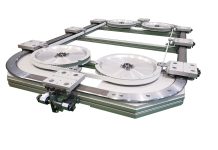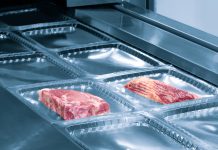
Excellent mechanical and optical properties, resistant to welding and perforation, anti-fog, single or multi-layer, practical, light-weight, suitable for freezing and micro-wave cooking, resealable: flexible packs dominate the food sector.
With a 90% share, flexible packs cover most of the packaged food and beverage sector. They include composite bags, typical for chip or snacks, pouches for cereals or coffee, or for packaging cured meats and cheese, as well as resealable squeezable stand-up pouches for fruit juices and wraps for sweets, and so on. Food sectors making most use of flexible packages are those of baked goods and pasta, especially due to the higher consumption of industrial and frozen fresh pasta, followed by milk and dairy products (cheese, divided in portions and pre-packed, yoghurt, butter). The increase in sales of portion-packed cold meats, directly pre-packed by industrial producers or by modern retailers, as well as of processed meats, has pushed even further the use of flexible packages. They are frequently used even in the sector of deep-frozen products, for 4th range products and ready meals, and whenever protective atmosphere is required. Flexible composite packages show positive growth rates for preserved pulses, tomato-based products for the Catering (Ho.Re.Ca.) sector, sauces and fish products of aquaculture origin. Different types of packaging materials are being used, such as: plastic films, plastic bags and pouches, plastic shrink and stretch films, paper labels, paper and aluminium wraps. Their extensive use results from convenience of transport, capacity to protect the packaged goods, visual impact and appeal provided by modern printing systems (rotogravure and flexography). Further development of the flexible packaging market will heavily depend on the growth trend of specific food products such as ready meals, single-dose packs, frozen and 4th range products. Over the last years, the turnover of Italian suppliers of flexible packaging products recorded strong growth trends, especially in exports to US and non-EU countries. An additional drive may be created by the markets of Africa and China, still offering high penetration margins, unlike the Italian and EU market, which are mature. Within the EU, the largest users of flexible packaging materials are Germany and France. In Italy, this development can be served only by the decrease of other packaging materials, and the establishment of modern lifestyles of single consumers and small households. A very interesting sector, in fact, according to a study conducted by Ceresana, a market research company, pointing out that the European market for flexible packaging is expected to reach a market volume of about 19.2 million tonnes in 2021. It results that stand-up pouches are an important growth segment on the market for flexible packaging, progressively replacing metal cans and rigid plastic containers.
Attention to the environment
Different types of packages (plastic packaging film, plastic carrier bags and sacks, plastic shrink and stretch films, paper labels, etc.) correspond to as many types of materials: polyethylene (PE), polypropylene (PP), polyethylene terephthalate (PET), polyvinyl chloride (PVC), other plastic materials, paper and aluminium. The decision to use single or multiple layer materials is closely related to the properties of the food product that it shall contain, and to its required shelf-life. Many properties drive food industries towards environmental-friendly flexible packaging materials that contribute to saving raw materials. All flexible packaging materials (metal or composite film in rolls) are characterized by their lightness. Over the years the weight of flexible packaging materials has decreased, while keeping the same performance levels. This reduction is the result of lighter materials and new processing technologies. In fact, alufoil can be replaced by the metalization of plastic films. Paper and cardboard use is decreasing as well, replaced by plastic films obtained by coupling polymers, which register a steady growth. Even the use of barrier films leads to a reduction of film layers or thickness. In coherence with the general concern for the environment, whenever possible, non-recyclable materials are replaced with alternative materials, as biodegradable, compostable (PLA) and oxodegradable films. All these small actions provide an additional reduction of the film thickness, without affecting the pack resistance to external agents. Reduced footprint provides considerable energy savings, and simpler transportation. Resealable flexible packs contribute to reduce food wastes, consumers being more attentive and sensitive both for environmental and economic reasons. On the environmental front, the recycling issue must be improved compared to paper or glass packaging materials. Solutions have been proposed such as using flexible packaging materials in waste-to-energy plants for heat generation, water heating, or the generation of heat, or the production of electricity.

To each foodstuff its own film
Fruit and vegetables make extensive use of flexible packaging materials: bags and sacks on roll, single-ply or multi-ply, for automatic packaging of apples, carrots, potatoes, as well as wicket bags, macro and micro-perforated or punched. Polyethylene and polypropylene covers for plastic, wood and cardboard crates, personalised, punched or not, for the packaging of fruit, vegetables and citrus products. Extruded and woven tubular nets for packaging of garlic and onions. Flexible packaging materials for meat, sausages and cheese must guarantee barrier properties to ensure long-term maintenance and protection of the packed product. To this purpose co-extruded and laminated films, with specific thermoforming properties, a wide range of sealability, gas barrier and puncture resistance are used. The film can be pasteurizable and sterilized, peelable and not, rigid or semi-rigid, suitable for packaging machines microwaveable and suitable for horizontal, vertical and thermoforming. For the packaging of snacks and baked goods, films ensuring high optical characteristics and excellent resistance of sealing are used. The film can be neutral or printed with flexographic or gravure printing, metalized or non metalized, with barrier and suitable for modified atmosphere packaging. Single-layer and multi-layer bags and films with specific characteristics of slipperiness, sealability and high resistance to low temperatures are mostly used for the packaging of – even chilled – fish products. For packaging of ground coffee of coffee beans, extremely flexible packaging materials are used, suitable for the production of vacuum packs, coffee pods and preformed bags with degassing valve. Latest trends impose the use of high-barrier metalized polypropylene with values close to those of aluminium.
High-performing glues
A wide range of glues is available for the lamination of plastic, aluminium, and paper films, all of them typical materials of the food sector. There are polyurethane adhesives, with or without solvent; when extruded in the polyethylene film, hot-melt adhesives allowing the production of resealable packages, increasingly in demand for packaging a variety of foodstuffs. Some adhesives can be applied at low temperatures, and ensure high laminating speeds, as well as resealability and longer freshness of the food product. Waterborne polyurethane adhesives for flexible packaging materials, which, according to a research conducted by the Packaging Division of the Department of Food, Environmental and Nutritional Sciences of the University of Milan, show enhanced physical properties along with increased sustainability values, opening new paths for the flexible packaging industry. The project “Strategies for implementing nano-cellulose coatings in flexible packaging” aimed at evaluating the feasibility of new multilayer structures for high-performing flexible packaging applications. To this purpose a CMC (Cellulose Nano-Crystals) coated film was laminated on polyester using special waterborne adhesives. The best results in terms of oxygen-barrier and mechanical properties have been obtained with the combination PET coated (CNC)/PE. The final packaging (PET/CNC/waterborne PUD adhesive/PE) provides several fundamental efficiencies, as low environmental impact thanks to the use of one film less. Furthermore, nano-cellulose is obtained from renewable nature; non-food agricultural based sources; it provides biodegradability and/or biocompatibility, low cost and low energy consumption. Special polyurethane adhesives for the flexible food packaging industries entered the market, either solvent-based or solvent-free. They offer good thermal and chemical resistance, and the possibility to treat the completed film (film, metalized and film, aluminium, paper) structures through sterilization and pasteurization processes, typical of the food industry. These adhesives can be used with different mixing rations, according to the expected performances. Furthermore, they offer good adhesion and wettability properties, allowing for excellent final optics.




